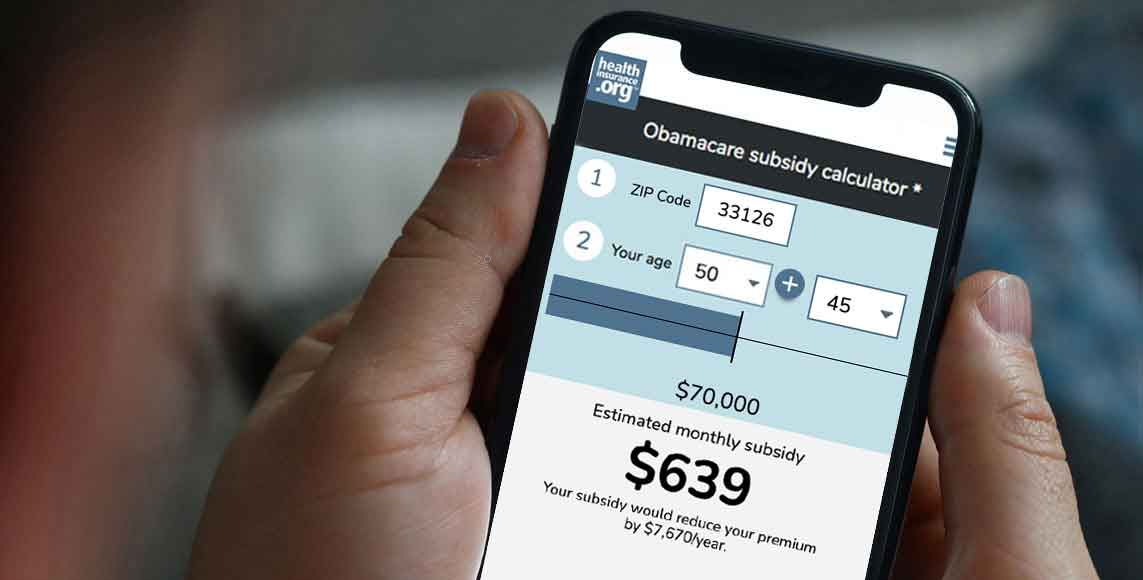Q. I keep hearing about the “coverage gap” in states that are not expanding Medicaid. Can you explain what that means and who it affects?
A: We’ll get into the details below, but the short answer is that people with income below the poverty level are not eligible for the Affordable Care Act’s (ACA) premium tax credits (premium subsidies), and if they’re in a state that has refused to expand Medicaid eligibility under the ACA, they may not be eligible for Medicaid either.
That leaves them in a situation in which they’re living in poverty but also ineligible for financial assistance with their health insurance. An estimated 1.9 million Americans are currently in the coverage gap.1
To clarify, the coverage gap only exists in nine states, and it’s entirely caused by those states’ decision to not expand Medicaid. The ACA did not create any sort of coverage gap; the law was purposely designed to ensure that there would be no coverage gaps for low-income Americans, even for recent immigrants (as long as they’re lawfully present in the US).
Why is there a Medicaid coverage gap in some states?
When the Affordable Care Act was written, a cornerstone of the legislation was the expansion of Medicaid to adults under age 65 with household incomes up to 138% of federal poverty level/FPL. (Note that children were already eligible for Medicaid with household income above that threshold; different Medicaid eligibility rules exist for people age 65 and older, including both income and asset limits.)
Originally, the law required states to expand Medicaid (funded mostly by the federal government) to continue to receive their regular federal Medicaid funding. Then in 2012, the Supreme Court upheld the rest of the ACA but struck down the Medicaid expansion requirement, leaving it up to each state to decide whether or not to participate. Under the Court’s ruling, states would no longer lose their regular federal Medicaid funding, even if they refused to implement Medicaid expansion.
And some states have continued to refuse to expand Medicaid. The ACA’s premium subsidies aren’t available to people with income below the poverty level, because the law had called for them to have access to Medicaid instead. But if they’re ineligible for Medicaid under state rules, they are essentially stuck with no viable coverage options. They can’t get Medicaid, and they also can’t get subsidized coverage in the Marketplace/exchange.
Which states have a Medicaid coverage gap?
As of late 2023, ten states have not expanded Medicaid. There is a coverage gap in nine of them:
- Alabama
- Florida
- Georgia (coverage is available, but only if a person is working and reporting it)
- Kansas
- Mississippi
- South Carolina
- Tennessee
- Texas
- Wyoming
(Wisconsin partially expanded Medicaid, so although the state has not implemented the ACA’s expansion and thus does not receive the ACA’s enhanced federal funding for Medicaid expansion, there is no coverage gap in Wisconsin).
Will the rest of the states close their Medicaid coverage gaps?
Voters in Oklahoma and Missouri approved Medicaid expansion ballot measures in 2020, so Medicaid expansion took effect in those two states in 2021. The same thing happened in South Dakota in the 2022 election, paving the way for Medicaid expansion to take effect in that state in July 2023. and North Carolina expanded Medicaid starting in December 2023, under the terms of legislation the state enacted earlier in 2023.
So the number of Medicaid expansion states has grown from 26 to 40 over the last decade, and the coverage gap has closed in 14 states. But it’s noteworthy that the majority of the recent expansions have been due to voter-approved ballot measures, and those are not an option in the nine states that still have a coverage gap. It’s possible that some of these remaining states might consider legislative action to expand Medicaid, but not widely expected soon.3
Medicaid eligibility varies depending on where you live
In the states where Medicaid eligibility has been expanded, adults under the age of 65 (who meet the immigration status requirements) are eligible for Medicaid with a household income up to 138% of FPL are eligible for Medicaid. (Note that Washington, D.C. has a higher income cap for Medicaid eligibility, at 215% of the poverty level. And Connecticut offers Medicaid to parents of minor children with household income up to 160% of the poverty level).
But in the states that have not expanded Medicaid, eligibility is still based on pre-ACA guidelines. In most cases, that means Medicaid is only available to people with disabilities, low-income children and pregnant women, and extremely low-income parents. In Alabama, for example, Medicaid is available for parents with a household income of up to 18% of FPL (13% plus the 5% income disregard). For a family of three, that’s $4,475 in annual income in 2023. If the family’s income exceeds that amount, the parents would not qualify for Medicaid.
Medicaid is generally not available at all to childless adults in states not expanding Medicaid, regardless of how low their income is. (This chart has income limits for Medicaid in each state, and contact information for each state’s Medicaid Department is available here.)
The coverage gap: No realistic access to health insurance
The “coverage gap” exists because the ACA’s premium tax credits (premium subsidies) are only available for people with a household income of at least 100% of FPL, up to 400% of FPL. (Note that the American Rescue Plan has eliminated the upper income limit for premium subsidy eligibility, and the Inflation Reduction Act extended that provision through 2025.)
Premium subsidies are not available below 100% of FPL, because when the ACA was written, Medicaid expansion was an integral part of the law: It was assumed that subsidies would not be needed below 100% of FPL, since Medicaid would be available instead.
So in states that are not expanding Medicaid, virtually all non-disabled childless adults with incomes below 100% of FPL, as well as a large number of parents with incomes below 100% of FPL, are not eligible for any financial assistance to help them afford health insurance. Premium subsidies are not available to them through the exchange/marketplace, and they don’t qualify for Medicaid unless they meet the stringent existing guidelines.
According to KFF data, there are about 1.9 million people in the coverage gap across the nine states that do not provide Medicaid coverage for adults with income under the poverty level. The majority of the people in the coverage gap are in Texas, Florida, and Georgia — more than 1.4 million of the people in the coverage gap are in those three states.
Households with incomes below 100% of FPL generally cannot afford to pay full price for health insurance. In most cases, they will remain uninsured, simply because they have no other alternatives. Unfortunately, this disproportionately impacts people of color, particularly in the southern United States where almost all of the states have maintained their pre-ACA Medicaid eligibility guidelines.
Possible solutions if you’re in the coverage gap
If you’re in the coverage gap, Medicaid isn’t available, and ACA-compliant coverage can only be purchased at full price – generally an unrealistic option, given that everyone in the coverage gap has an income below the poverty level. There are a few possible solutions, not all of which are adequate or realistic:
For coverage
- Read this article, about strategies for avoiding the coverage gap.
- You could move to a state that has expanded Medicaid, but that may be easier said than done for people with low-wage jobs, few assets, and few prospects elsewhere.
- You could increase your income to at least the federal poverty level (FPL), in order to obtain subsidized health coverage (if that happens mid-year, you’ll qualify for a special enrollment period during which you can enroll in a subsidized plan). Again, this is easier said than done depending on one’s circumstances. Navigators have been invaluable in helping poor people tally up income from varied sources in order to get their total income up to the poverty level, where subsidies become available.
- You can purchase a non-ACA compliant plan, which includes things like short-term health insurance, accident insurance supplements, critical illness insurance, discount plans, direct primary care plans, or health care sharing ministry plans. Although in most cases – with the exception of short-term insurance and health care sharing ministries – these were never intended to be stand-alone coverage, and some are not regulated by state insurance departments or subject to state/federal insurance laws.
For care
- Free clinics and federally funded community health centers provide a wide range of preventive and primary care services for people in the coverage gap. More than a million low-income, uninsured Americans rely on community health centers that offer care on a sliding fee scale. And the ACA provided funding to increase the number of community health centers across the country. For many in the coverage gap, a community health center is their only realistic access to care, although treatment is limited to primary care.
- You can rely on EMTALA for emergency situations. Emergency departments cannot turn patients away due to inability to pay. However, emergency departments are only required to stabilize patients; there’s no provision for ongoing treatment under EMTALA. And the emergency department can still send you a bill that can be sent to collections if it’s not paid (they cannot, however, withhold future emergency stabilization treatment due to past-due prior bills).
American Rescue Plan provides additional funding to entice holdout states to expand Medicaid
The American Rescue Plan (ARP), enacted in March 2021, provides two years of additional federal funding for states that newly expand Medicaid. The federal government already pays 90% of the cost of covering the population that’s eligible due to the ACA’s expansion of Medicaid, but it pays a varying percentage of the cost of covering each state’s additional Medicaid population — normally ranging from 50% to about 75%.
Due to the COVID pandemic, the federal government was already giving states an extra 6.2% in federal matching funds for their non-expansion Medicaid populations. And if any of the remaining states expand Medicaid, the ARP will give them an additional 5% in federal matching funds for two years. Some of the holdout states have actively considered Medicaid expansion as a result, despite years of rejecting it.
By late 2023, more than two years after the ARP was enacted, only Oklahoma, Missouri, South Dakota and North Carolina had newly expanded coverage (all are receiving the additional ARP funding as a result). Oklahoma and Missouri had already scheduled Medicaid expansion to take effect in 2021, with the process underway before the ARP was enacted.
Georgia implemented a partial Medicaid expansion in the summer of 2023, but Georgia imposes a work requirement for this population so total enrollment in the program is expected to remain significantly lower than it would be with full Medicaid expansion. And because Georgia has strings attached to its Medicaid “expansion,” there is still a coverage gap in the state. Georgia is not receiving the additional funding (or regular enhanced federal Medicaid expansion funding), since the state is not fully expanding Medicaid. States are not eligible for enhanced federal Medicaid expansion funding or the additional ARP funding unless they fully expand Medicaid to cover people up to 138% of the poverty level.
Louise Norris is an individual health insurance broker who has been writing about health insurance and health reform since 2006. She has written dozens of opinions and educational pieces about the Affordable Care Act for healthinsurance.org.
Footnotes
- How Many Uninsured Are in the Coverage Gap and How Many Could be Eligible if All States Adopted the Medicaid Expansion? KFF. March 2023. ⤶
- Medicaid on the Eve of Expansion: A Survey of State Medicaid Officials on the Affordable Care Act. National Institutes of Health. August 2017. ⤶
- An Update on ACA Medicaid Expansion: What to Watch in North Carolina and Beyond. KFF. December 2023. ⤶












